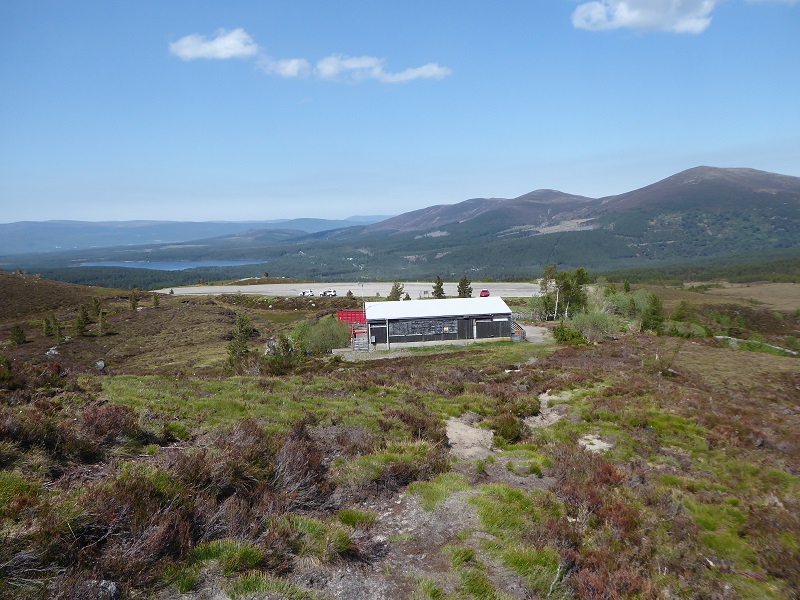
The idea of developing facilities for campervans at the Coire na Ciste car park is, in principle, quite sensible. Even though the Glenmore campsite has opened up this year, there are a lack of facilities in Glen More and a shortage of informal places to stop off overnight. Meantime, the Coire na Ciste car park, dating from the heyday of downhill skiiing at Cairn Gorm, offers a large expanse of tarmac and gravel which is generally underused and in need of a large dose of tender loving care. It provides an opportunity, therefore, for Highlands and Islands Enterprise (HIE) and Cairngorm Mountain Scotland Ltd (CMSL) to do something positive for Cairn Gorm, after the disastrous mismanagement of the last twenty years.
Unfortunately, the Planning Application which is due to be considered by the Cairngorms National Park Authority (CNPA) on Friday (see here) is not just a missed opportunity, it promises another low quality eyesore.
Campervan facilities and the long-promised masterplan
Developing facilities for campervans was one of the “activities” that HIE promised to consider further in its consultation document, “Cairn Gorm: Towards a Vision and a Masterplan”, published in July last year (see here). According to that document:
“All future activates and proposals for the mountain will be assessed against:
• The visions guiding principles and HIE’s core objectives
• Key Strategies
• The Masterplan“.
HIE has been promising a masterplan for Cairn Gorm since October 2016, when it committed to do so as part of the Cairngorm and Glenmore Strategy. At the end of last year it indicated the masterplan would be completed early this year. There is still no sign of the document and therefore there has been no assessment of how this planning application fits with HIE’s plans for Cairn Gorm as a whole.
The CNPA Board adopted a set of principles in March 2019 which called for a masterplan before any further planning applications were submitted at Cairn Gorm (see here). HIE has repeatedly ignored that request, submitting Planning Applications for the Ptarmigan, tube slides, snow making machines, electronic gates at the Coire Cas car park and the repair of the funicular since then. While previous reports to the CNPA Planning Committee have referred to the need for a masterplan, the current Committee Report is silent on the matter. This is despite the Local Development Plan for the Cairngorms, which was formally adopted in March, requiring that planning applications at the three ski centres in the National Park:
“should be supported by a masterplan or similar document which outlines the longer term development strategy for the centre and explains how the proposal fits within this.” (Para 4.39 here).
While CNPA officers appear to be ignoring their own Local Development Plan, HIE has been quietly amending its vision for Cairn Gorm:
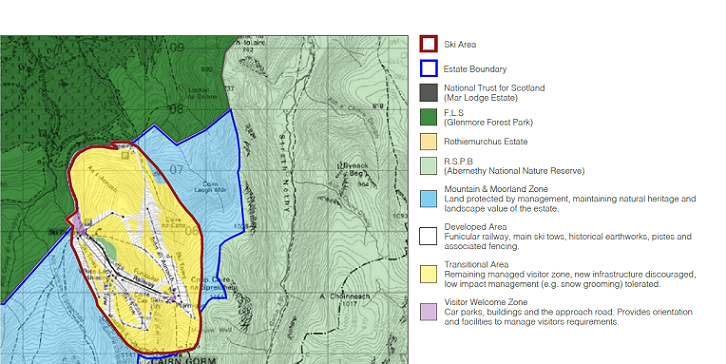
Last year HIE proposed what it described as two “Visitor Welcome Areas”, one in Coire Cas and a second at the Ptarmigan (presumably for the handful of people who walk over to Cairn Gorm from Deeside!). Parkswatch commented at the time that the Coire na Ciste car park should also have been treated as an entry point…………
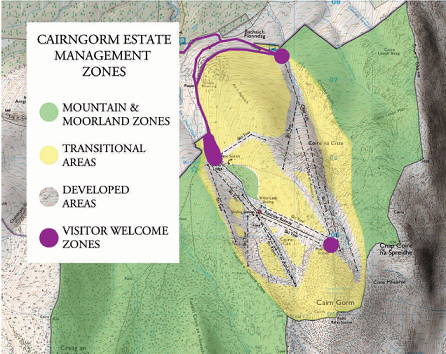
………….and now it is! HIE have clearly been updating their masterplan document, so why hasn’t this been provided to the CNPA? And why have CNPA officers not demanded it be made public?
The proposal

The Planning Application is to create a fenced off parking area for 50 motorhomes, reduced from 68 in the original application, a tap, a facility to dispose of chemical waste and a litter collection point. There is no mention of any electric hook-ups so it appears these are not included in the proposal.
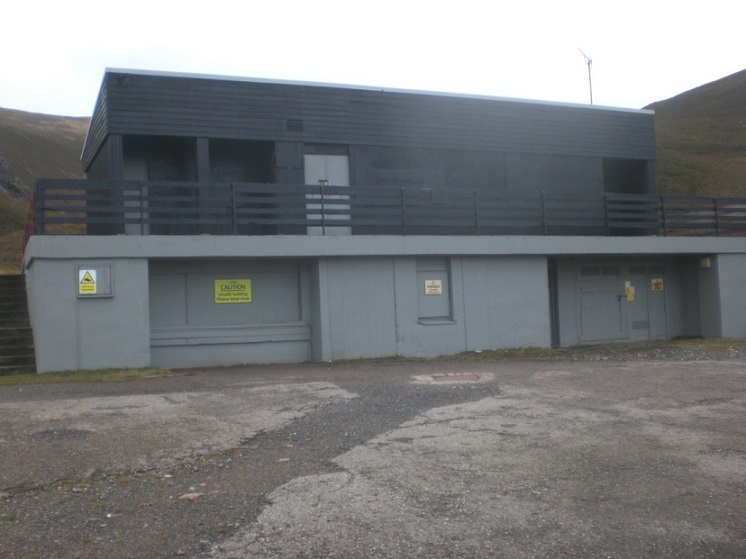
The building above the Ciste car park, which had been subject to two previous planning applications and has been condemned as unsafe (see here), sits outwith the planning application boundary. Conveniently, it has also been omitted from the maps submitted with the application. The future of the building, and the potential for the toilets there to be brought back into public use, are therefore not on the planning agenda.
CNPA Board Members could still ask whether its sensible for a Public Authority to aim to attract dozens more people to the vicinity of a building that has been condemned as unsafe? Or even what HIE’s future intentions for the building are within the context of a masterplan?
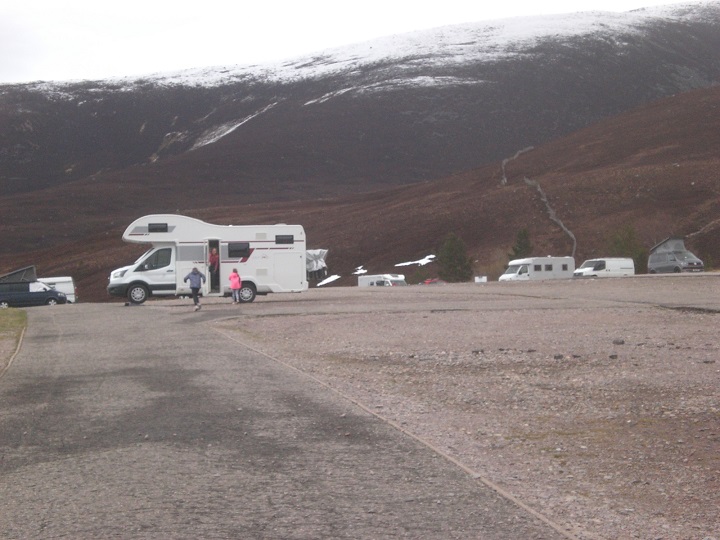
In the absence of functioning toilets, HIE is proposing to restrict use of the site to motorhomes “with cassettes”, i.e have their own facilities. The evidence, as captured in the photo above, is that approximately half of the vehicles that stay overnight currently are campervans [NB this has been updated as result of comment below – more campervans have toilets than I realised] not all of which have their own internal toilets. The Planning Application therefore has the potential to displace some campervans back down into Glenmore, adding to the problems there. It is possible, that HIE is proposing to divert campervans without toilets to stay overnight in Coire Cas, where it states it has plans to open a 24 hour public toilet. Unfortunately, without a masterplan, neither the general public nor the CNPA can have any idea of what HIE’s true intentions are or any means to holding them to account.
What HIE/CMSL intends to charge is unclear. How much motorhomes, which tend to use more electrical appliances than campervans, will be prepared to pay for staying on a site without electricity is unclear.
CMSL’s supporting paper on Visitor Management refers to the application as “a Phase 1 proposal that can be improved on as more revenue is generated in future years and the Cairngorm Masterplan is realised“. While this reinforces the need for the masterplan to be made public, providing toilets, wash facilities – a shower might be appreciated – and electricity would cost a fraction of the £16m HIE is spending on the repair of the funicular and the annual subsidy that it has committed to CMSL over the next 30 years (see here). So why can’t HIE use some of that huge slush fund to invest in facilities that might actually help people and reduce pressures on Glen More?
It shouldn’t take a genius to work out that good facilities are far more likely to attract people than a few lines on tarmac on gravel.
Impact of the development on the landscape
The reduction in the number of motorhome from 68 to 50 appears to have been a result of concerns from the CNPA’s landscape adviser. Although motorhomes tend to be far more conspicuous than campervans, no other measures are proposed to reduce their visual impact or improve the landscaping of the car park.
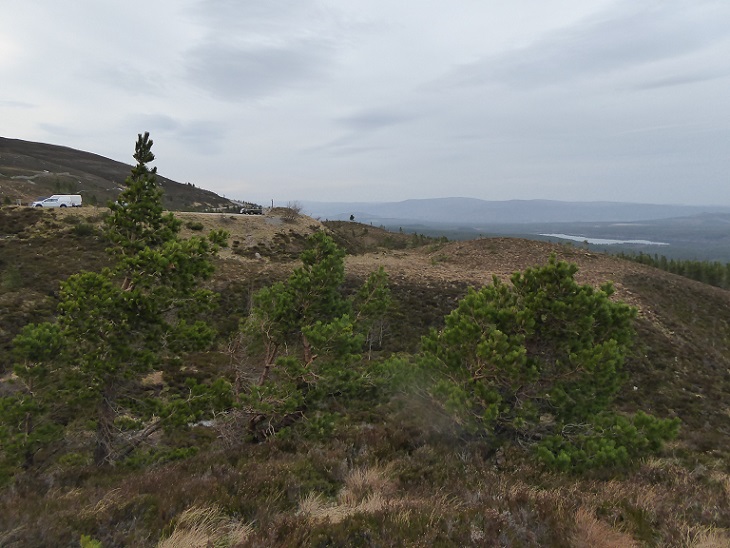
In the longer term natural regeneration around the site could conceal the car park entirely. That could be helped by a bit of judicious planting on the soils that were disturbed by its construction. But there is also plenty of scope to break up and soften the large expanse of tarmac and gravel through tree planting. Such landscaping would make Coire na Ciste a much more attractive place to stay.
The Planning Application, however, pays no attention to the “visitor experience”. Parkswatch recently (see here) brought attention to the multiple issues that affect the amenity of the area and ability of the public to enjoy it. It was gratifying that within a couple of days of the post the sign that had lain by the sugar bowl for over a year  (left) was removed, presumably by Forestry and Land Scotland. Well done them! By contrast,Cairngorm Mountain Scotland Ltd, appear to make a point of not addressing problems brought to their attention.
(left) was removed, presumably by Forestry and Land Scotland. Well done them! By contrast,Cairngorm Mountain Scotland Ltd, appear to make a point of not addressing problems brought to their attention.
An excellent example of this are the exposed powerlines by the path into Coire na Ciste which have now been covered by sandbags. Here is what CMSL have to say about that issue in the planning documents:

The inconvenient fact, ignored here, is that the natural topography above the car park invites the visitor to walk up into Coire na Ciste. How CMSL intend to discourage people from doing so is unclear but they are unlikely to be successful without fences (see below).
CMSL also failed to mention that as well as the cables, there is significant damage from erosion that has been in need of repair for years:
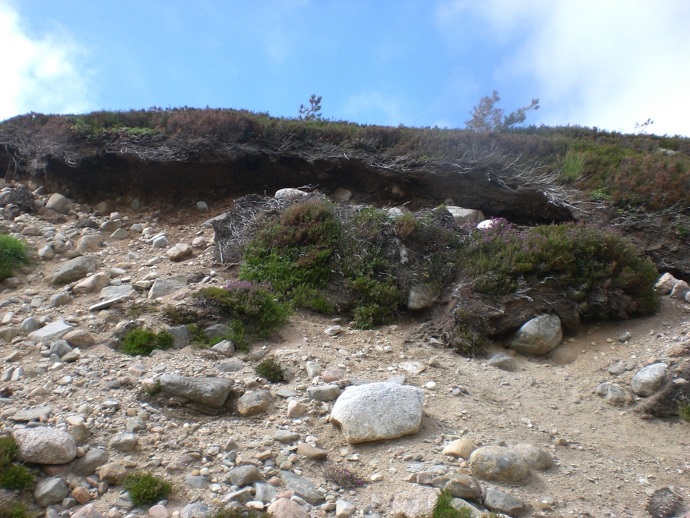
The creation of a new visitor “welcome point” at Coire na Ciste should have prompted a review of what needed to be done in the surrounding area to restore past environmental damage and help those staying overnight to enjoy it.
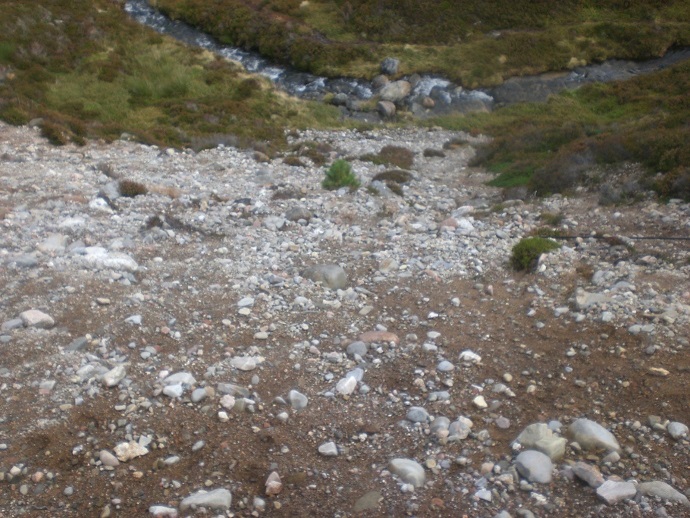
HIE/CMSL’s failure to address these issues should surprise no-one, it all goes back to the disastrous decision to transfer the Cairngorm Mountain Estate from the Forestry Commission to the then Highlands and Islands Development Board. Since the, care of the natural environment at Cairn Gorm has always come a poor third.
Curtailing public rights
Highland Council Roads Department in their response to the application, failed to comment on how the fences and gates that HIE proposes to install will affect the public road. This is despite the fact that the road, which is their legal responsibility, appears to run though the car park:

If my interpretation of this information is right (others have submitted FOI requests to determine the exact course of the road), approval of the planning application would effectively allow HIE to annex a section of public road for its own purposes without following due process. This follows HIE’s unlawful closure of the public road up to Cairn Gorm during lockdown. It amazing how our public authorities ignore the law when it suits them.
The reason a boundary fence has been included in the plans for the car park is because of the Habitats Regulations Appraisal conducted by the Cairngorms National Park Authority (see here):
“To reduce the risk of increased use of the BLANK [redacted] route as much as possible, to avoid increased activity in sensitive capercaillie woods over and above existing levels of activity.
The mitigation required for HRA purposes, as conditions of any permission granted, is:
– Perimeter post and rail fence as marked on the site layout plan to be in place prior to the
car park being used for booked overnight motorhome stays, and maintained in perpetuity
while the motorhome overnight parking is in operation. The specification and location of
the fencing to be agreed with CNPA prior to installation. [ Reason: To discourage people
from undertaking off path activities or increasing use of routes connected to sensitive
habitat, therefore minimising the potential for likely significant effects on capercaillie
habitat in the Cairngorms SPA.]”
What is the logic of installing fences to “protect” capercaillie, one might ask, when fences are known to be of the main causes of premature death in capercaillie (see here)? This stupid proposal also has serious implications for access rights and goes a step further than the signs that Cairngorms Capercaillie Project has erected at Carrbridge (see here). Those signs tell people to keep their dog on a lead and warn that anyone disturbing capercaillie may be committing a criminal offence, but at least they only apply for a few months of the year. Now the CNPA is promoting the erection of physical barriers along the western and northern boundaries of the car park that are designed to stop people and could kill capercaillie year round. All this, just to prevent people accessing one route, a route that Forestry and Land Scotland says is rarely used anyway, where there is no evidence have been disturbed and where the maximum increase in usage is predicted to be less than 10%!
The main attraction of the Coire na Ciste car park at present are the uninterrupted views out over Glen More. No consideration has been given to the impact that fences will have on this – the design has not yet been agreed – but between them CNPA and HIE have turned what could have potentially be a wonderful facility into something that is likely to feel more akin to a prison camp. Instead of wasting money on fencing, the CNPA could have required HIE to invest in improving the paths from the car park, including that up in Coire na Ciste, which naturally lead people away from the area where capercaillie are found. Alternatively, a short new path to a “hide” could have provided a way for those who wanted a chance to see the capercaillie without disturbing them. Why weren’t these options considered and consulted on with organisations representing recreational interests?
What needs to happen?
Cairn Gorm, despite HIE’s legacy of mis-managment, is a fine mountain and the most visited in the National Park. It deserves only the best. Instead, on Friday, the CNPA Planning Committee (the meeting starts at 10am and can be followed here) is being asked to approve a third rate planning application, made worse by the ill-thought out proposal to erect fences and barriers around the site and across the public road.
The CNPA Planning Committee should:
- Refuse to approve the Planning Application until HIE has agreed with them a masterplan for the whole of Cairn Gorm, including longer terms proposals for the Ciste car park and the surrounding area;
- Advise HIE that any revised application for a formal overnight stay area for campervans must have suitable facilities, including toilets and electric hook-ups, and should include proposals to improve the landscaping of the car park;
- Advise HIE and officers to develop a visitor management plan that facilitates enjoyment of the wider area by those staying at Coire na Ciste and protects wildlife without the use offencing.
It’s clear that the road within the Coire na Ciste carpark is a public road. It’s 861 yards in length which means that it does run the full length of the Ciste carpark. Highland Council Roads and Transport had this to say: ”We are not aware of any moves to amend the status of any road in this area. The adopted status of a road is not affected by ownership of the solum and any change in the adopted status of a road would be subject to public consultation” CMSL have not sought to change the adopted status of the road and there has certainly been no public consultation. Despite the fact that The CNPA Planning Committee will be under pressure to approve this planning application they must question its validity on the basis of the road status.
While not entirely confined to the Cairngorm issue, the willingness of public authorities to always consider the “grand scheme” but deny the wider problem is manifest here again. The need for un-monitored hard standing on which Camper vans and motor homes may be free to park overnight exists right across the highlands. Any attempt to corral these touring vans into a few “mega parks” , behind barriers and turnstiles such as proposed here will not work. Denying to the occupants the sense of peace and tranquility , which is the essence of the Highland experience, will lead to them turning round after a few minutes, and moving on, hunting for a quieter alternative.
Perhaps councilors themselves have never attempted to rest overnight in a place where traffic movements will be continuous and there will be no “quiet” hours at all? The revving of engines as newcomers arrive late, “early birds” attempt to leave, along with the banging of doors, the inevitable conversations as families enjoy the space..all of this mitigates strongly against any plan for a ‘mega’ site here on Cairngorm or anywhere else for that matter. What The Highlands needs to see is a clear planning policy that permits land Owners to offer hard standing ares for a couple of vans at hundreds of places. It is hardly difficult to do. What is required is the political will- the legal framework to permit and encourage small scale places this..not grandiose splurges of public “fuuuunding” for predictable failures.
I might add,this parallel. For yachtsmen across Europe and in many nations worldwide, schemes exist, which in essence are not so dissimilar to what I am proposing here. Instead of each yacht damaging the marine environment by dropping anchors one after another onto the same seabed ecosystem, certified visitor moorings have been established by public Authority or subscriber group. A yacht may subscribe and register online to use these or they may be sponsored by some national tourism authority. ( in some cases the individual payment when offered via a G4 network smart phone can be GPS identified.)
Of course for any such facility there is always some risk of “freeloaders” taking advantage, but overall the outcome of these schemes is better, neater, easier to monitor both for the yachts concerned, and also for the local community who might help sponsor the mooring area, to bring footfall to their local attractions. (Incidentally, sound well engineered moorings, as with well drained hard standings for camper vans are also somewhat safer for hire operators and insurers.) The permanence of the small and very local facility, instead of thousands of random anchors for boats , (ruts or muddy wallow holes for wheels in field, track and forest entrances,) is of course wholly respectful for the environment.
Hi Tom, very interesting comments. Generally, I agree it would be far better to have many small places where campervans/motorhomes could pull off the road and stay the night, rather than go for big “parks”. There is a parallel between what’s happening with campervans (with many small places being blocked off by boulders by councils and landowners) and what has happened with camping in the Loch Lomond and Trossachs National Park. Instead of people being able to spread out they have been crammed into a few limited permit areas, increasing problems there and making the experience far less enjoyable. However, the situation at Glenmore is a bit more complicated, partly because its the main visitor honeypot in the Cairngorms National Park but also because a large amount of the forest is protected and, under the current designation system, there is very little scope for creating small pull off areas low down. There is some sense therefore in using the Coire na Ciste car park for campervanners wanting to visit Glenmore. Following on from what you say – and my comments on the lack of landscaping – there is obvious potential to help campervans spread out around the car park instead of cramming them into one designated area. The car park is plenty large enough to do that and if a similar approach was taken at Coire Cas, a relatively large number of campervans might be accommodated without people getting on top of each other and destroying the experience.
I have a small t5 campervan and have my own toilet facilities the same as the larger motorhomes. Most of us do (porta potto) and dispose appropriately the same as larger motorhomes, in the same disposal facilities.
Thank you Carol, apologies for mistake – another reader has made the same point – and I have revised the piece to take account of this
As the location is above the tree line, whilst with its magnificent views it seems to be a great location to overnight in a camper van, it is too exposed to wind, and as such difficult to rest easy without thinking that the pop top roof is going to be damaged/ torn off or the van rocks too much to sleep.
It would be preferable to have more smaller locations dotted within the tree line adjacent to the road.
Thanks for your informed review of this ill-conceived planning application. As you point out, the poor quality of the scheme is further downrated by the stupid recommendation by the CNPA Conservation Team of insisting that the motor home park is fenced off. Even if the final fence design is as ‘capercaillie friendly’ as possible, how well will the design work in the often poor visibility conditions found in this area. Additionally, unless motor home users are prevented from leaving the facility to go for a walk or stroll, how is a fence going to stop them. The fencing concept is close to lunacy.
Oh, and yet again the CNPA Planning Committee, under advice from their planners, will yet again duck out of their responsibilities to insist on a published masterplan before granting planning consent. Another example of CNPA being long on words and desperately short on actions.
I am just continually saddened by the random and chaotic approach in a place that should be such an asset for the local community and Scotland as a whole. The calls for a master plan have a logic to them but even if one was provided it seems very unlikely that it would be complied with. More likely it would be abandoned at the first hint of the next sniff of instant cash. The status of any plan would be questionable anyway unless the CNPA were involved and guiding it’s production, they could then adopt it as supplementary guidance and it would have some teeth. The approach (and one I have seen before) seems to be to fill the place up with ad hoc developments until there is nothing left to master plan.
The CNPA is just another “fly” caught in HIE’s tangled web of deceit. Too many on the committee are afraid of the power wielded by HIE! It is hard to understand why they call in these planning applications when they have so little effect on them. And to top it all CMSL are calling the CNPA “colleagues”!
Speculation on the price motorhomers would be prepared to pay for non electric pitches that provide merely water plus waste disposal would be simple to ascertain. I would suggest that anything above £10 per night will merely make them seek cheaper/ free alternatives.